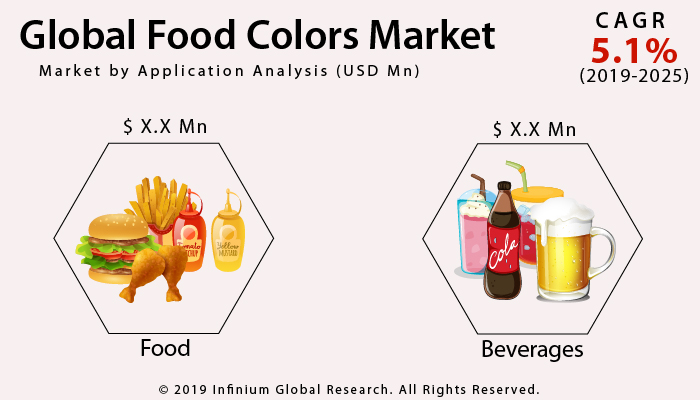Food Colors Market (Type - Natural Colors, Synthetic, and Nature Identical; Application - Food, and Beverages; Form - Liquid, Powder, Gel, and Paste; Solubility - Dyes and Lakes): Global Industry Analysis, Trends, Size, Share and Forecasts to 2025
A recent report published by Infinium Global Research on food
colors market provides in-depth analysis of segments and sub-segments in the
global as well as regional food colors market. The study also highlights the
impact of drivers, restraints, and macro indicators on the global and regional
food colors market over the short term as well as long term. The report is a
comprehensive presentation of trends, forecast and dollar values of global food
colors market. According to the report, the global food colors market is
projected to grow at a CAGR of 5.1% over the forecast period of 2019-2025.
Market Insight
Food colors are edible food ingredients used to impart special
colors, natural look to the different type of food & beverage products. It
comes in different forms such as liquid, gel, powder, and paste. It is derived
from various sources such as plants, fruits, vegetables, and numerous synthetic
sources. Further, nowadays, food colors are being mixed with fruit specific
flavors and aroma, which helps to enhance the taste level of the final food
products. As per the food industry safety assessment, application of the
synthetic food color is limited up to a maximum level of 200 ppm. This factor
is boosting the demand for natural food ingredients. Additionally, the growing
influence of health benefits of eating organic ingredients among the
health-conscious consumer group is helping to grow the demand for a different
type of natural food colors. Moreover, the growing disposable income among the
young consumer group in the developing countries is helping to grow the demand
for a different type of food colors used in the processed food products.
The continuous growing demand for a different type of processed
food and beverage products around the world is helping to grow the demand for a
different type of food colors products. Further, the implementation of the
several foods and beverage related rules for safe and natural food ingredient
is forcing the food and beverage manufacturers to use fine and safe quality
food ingredients in their food products offering. However, the availability of
the spurious and cheap quality of the food colors in the market is restricting
the growth of the demand for the good quality food colors market.
Geographically, the food colors market is divided into four
regions namely North America, Europe, the Asia-Pacific, and RoW. The North
America is the largest market of the food colors products, owing to the
presence of the several food and beverage processing industries in this region.
Additionally, the presence of a large number of the consumers for the different
type of the processed food and beverage products is continuously helping to
grow the demand of the several types of food ingredients in this region. Europe
is the second-largest market for the food color products after the North
America. The Asia-Pacific market is expected to grow at the highest CAGR during
the forecast period, owing to the growing disposable income among the youth and
middle-class consumers in this region.
Segment Covered
The report on global food colors market covers segments such as
type, application, form, and solubility. On the basis of type, the sub-markets
include natural colors, synthetic, and nature identical. On the basis of
application, the sub-markets include food, and beverages. On the basis of form,
the sub-markets include liquid, powder, gel, and paste. On the basis of
solubility, the sub-markets include dyes and lakes.

Companies Profiled:
The report provides profiles of the companies in the market such
as LycoRed Ltd., Frutarom Industries Ltd., Kalsec Europe Ltd, Fiorio Colori
Srl, Döhler, Digestive Disease Week, Naturex, Koninklijke DSM N.V., Sensient
Technologies, and E. I. du Pont de Nemours and Company.
Report Highlights:
The report provides deep insights into the demand forecasts, market trends, and micro and macro indicators. In addition, this report provides insights into the factors that are driving and restraining the growth in this market. Moreover, The IGR-Growth Matrix analysis given in the report brings an insight into the investment areas that existing or new market players can consider. The report provides insights into the market using analytical tools such as Porter's five forces analysis and DRO analysis of food colors market. Moreover, the study highlights current market trends and provides forecast from 2019-2025. We also have highlighted future trends in the market that will affect the demand during the forecast period. Moreover, the competitive analysis given in each regional market brings an insight into the market share of the leading players.
